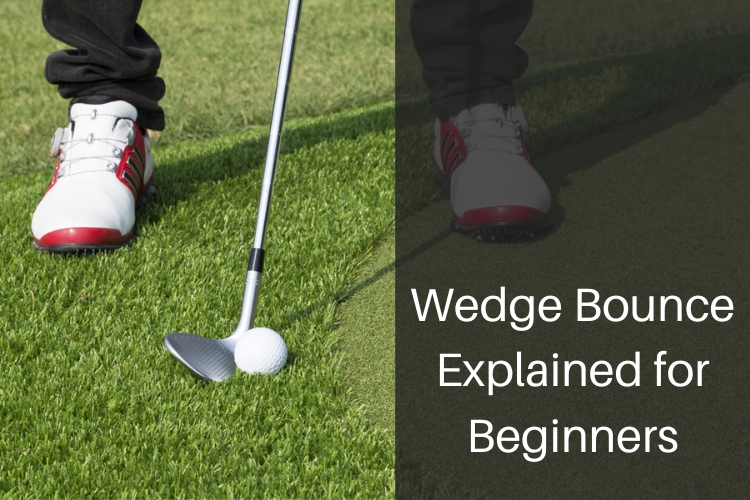What is bounce on a wedge?
In golf, wedge bounce refers to the angle between the club’s sole and the clubhead’s leading edge.
This angle is designed to help the clubhead glide through the turf and sand more easily, allowing the golfer to make a clean, controlled shot.
Wedge bounce is a crucial factor to consider when selecting a wedge, as it can affect how the club performs on different types of lies, such as the fairway, rough, and sand.
Wedges with higher bounce are generally better suited for softer, spongier lies, while wedges with less bounce are better for firmer, drier lies.
In this guide to wedge bounce, we’ll look at the three types of wedge bounce available to amateurs and how finding the proper wedge bounce for any situation can save strokes and lower scores.
3 Types of Wedge Bounce
Low Bounce Wedges
With a bounce angle of between 4-6 degrees, low bounce wedges are ideal for firmer turf conditions such as fairway shots and harder sand.
By using a low bounce sand wedge, golfers can ensure shallower attack angles can produce crisp contact with the harder turf conditions.
A low bounce wedge delivers precision. Advanced golfers use low bounce wedges with a neutral swing style to create predictable short game shots they can depend upon in any situation on the golf course.
For professional golfers like Tiger Woods, who use the popular Bob Vokey wedges, a sweeper swing style using a lob wedge helps him easily lift the golf ball.
Even with the leading edge digging into the turf facing tight lies, Woods can use the sole or trailing edge to get under the ball with a shallow angle of attack to produce the spin he desires to stop the shot cold on the green.
Mid Bounce Wedges
For mid bounce wedges, the bounce angle ranges from 7 to 10 degrees.
Mid handicappers with experience choose mid bounce wedges as the medium bounce provides total control of trajectory, distance, and spin.
Since low bounce wedges need a more precise swing type, these golfers enjoy the overall versatility of the mid bounce wedge with a clean sole grind.
Mid bounce wedges also can be used anywhere on the course. No matter if the shot is sitting pretty in the fairway or has unfortunately found a tight fairway bunker lie, these wedges offer a neutral setting that works with a moderate attack swing.
For golfers still looking to hone their short game and mid range game, mid bounce wedges are ideal.
High Bounce Wedges
With a high bounce wedge, the standard wedge bounce in this range is anything over 10 degrees. With this level of wedge bounce, golfers can increase swing speed on pitch shots and anything closer to the pin.
A correct wedge game move in soft sand calls for using a high bounce angle. The proper bounce matches the conditions, as a softer lie needs the right bounce to get the ball properly out of trouble and onto the putting surface.
Around the greens, high bounce lob wedges produce minimal divots with a steep attack angle, especially with softer conditions like fluffy lies.
In regular turf, high bounce wedges at the lowest point of attack create deep divots that help with trajectory control.
When looking at sole grinds with a high bounce wedge, Vokey’s wedges deliver a K grind and S grind style to produce a greater bounce angle and help increase short game production around the green.
Frequently Asked Questions
What bounce is best for wedges?
For wedge designers like Bob Vokey, the more bounce, the better for wedge shots.
But as technology has advanced, low bounce wedges and mid bounce wedges provide a weapon for firm turf conditions helping deliver clean ball contact.
Softer turf and soft sand shots demand high bounce wedges because the moderate attack angle allows golfers to produce deep divots into the soil and still achieve exact distance and spin.
There are a few different factors that can influence the amount of wedge bounce that a player needs, including their swing style, the type of course they are playing, and the type of shot they are trying to hit.
Some players may find that they prefer wedges with additional bounce, while others may prefer minimal bounce.
Is more bounce better for wedges?
When understanding wedge bounce, the rule has always been that an additional bounce angle provides a higher degree of forgiveness in a wedge.
A higher wedge bounce degree offers maximum forgiveness but also comes at the price of distance control and accuracy.
For inexperienced golfers, a higher bounce angle is the best bounce because this wedge bounce type can cover flawed swing types where consistency is harder to achieve.
With a low bounce wedge, the trailing edge is lower, helping produce flatter sole grinds that slide under the ball with a shallow swing type.
The low bounce wedges are weapons around the green because the low bounce angle helps with a flop shot swing type that produces a soft, fluffy high arcing shot that lands softly on the green.
For those reasons, experienced golfers find low bounce wedges to create the versatility and control they need for their short game.
Is 12 degrees of bounce too much?
No, 12 degrees isn’t too much bounce angle on high bounce wedges.
With greater bounce, meaning the angle created between the leading edge and sole is higher, golfers can increase their attack angle due to the deep forgiveness in a high bounce wedge.
Around the green, high bounce sand wedges with high wedge bounce deliver a softer landing with a higher spin.
High bounce wedges also allow golfers to hit tall high flop shots with the ability to create fast ball spin.
With the steep angle of attack, 12 degrees offers the best bounce angle for high handicappers and beginners looking to understand how bounce works with the clubs, such as a sand wedge.
Must read: How to Rust Wedges
